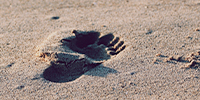Leveraging Prehistoric Footwear to Reconstruct Ancient Running Biomechanics

Running is an important cultural practice among modern Diné and Puebloan peoples, and has roots in prehistoric practice. Oral history suggests running was important in ceremony, communication, hunting, and warfare. However, prehistoric prevalence and rates of participation in running are poorly documented due to a paucity of direct archaeological evidence. Biomechanics of ancient human runners are poorly understood. Increased understanding of ancestral human biomechanics combined with an evolutionary medicine approach will improve health outcomes in sports medicine.
The extensive collection of well-preserved prehistoric footwear from the Southwest and Colorado Plateau at the Natural History Museum of Utah can provide insight into running practices and biomechanics among ancient peoples of the region through non-invasive imaging (3D and CT) and assessment of use-wear in conjunction with experimental work in collaboration with health sciences researchers. Minimalist runners will be recruited to wear traditional yucca-fiber sandals, manufactured by Native collaborators, while running and walking on laboratory treadmills to generate materials-appropriate use-wear predictions. Experimental footwear will then be scanned to compare to prehistoric wear patterns.
This project addresses university strategic goals by developing new knowledge, providing deeply engaged learning opportunities to students, and engaging regional native communities to improve health.
Current Status
2021-09-14
Abstract:
Running is an important, and even sacred, cultural practice among modern Indigenous peoples of the Great Basin, Colorado Plateau, and Southwest, and has deep roots in prehistoric practice. Oral history and limited archaeological evidence suggest that running was important in ceremonial contexts, communication between communities, in hunting practices, and in warfare. However, the prehistoric prevalence and rates of participation in running are poorly documented due to a paucity of direct evidence preserved in the archaeological record. Additionally, the biomechanics of ancient, minimally-shod runners (modern Homo sapiens) are not well-documented.
To address these questions, our team has developed an experimental archaeology and human subjects study aimed at reconstructing the biomechanics of running and walking using replicas of prehistoric yucca fiber sandals. Motion capture data, paired with data from instrumented insoles and treadmills, collected from minimalist runners running and walking while wearing replica yucca fiber sandals are used to generate use-wear predictions. These predictions regarding wear accrued during running and walking are then compared to use-wear patterns analyzed from 3D scans taken from the Natural History Museum of Utah’s collection of ~375 prehistoric yucca fiber sandals from across the Great Basin, Colorado Plateau, and Southwest.
We’d like to note the additional folks (including our Native collaborator, colleagues, and grad and undergrad students) who have significantly contributed to our project:
Jamie Herridge, Mary Weakhee, Gregory Burns, Alyson Wilkins, Hayley Kievman, Sofia Linskey, Olivera Masters, Caitlyn McAllister
Collaborators
Alexandra Greenwald
Natural History Museum of Utah
Anthropology
Project Owner
Andrew Anderson
School of Medicine
Orthopaedics
David Carrier
College of Science
School of Biological Sciences
Andrew Merryweather
College of Engineering
Mechanical Engineering
Project Info
Funded Project Amount$30K
Keywords
running biomechanics, minimalist running, ancient running, prehistoric Southwest and Colorado Plateau, prehistoric footwear, indigenous health, 3D geometric morphometrics, running gait mechanics, sports medicine, evolutionary medicine
Project Status
Funded 2020
Poster
View poster (pdf)
